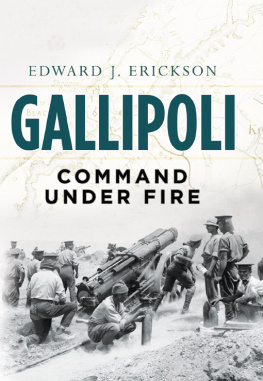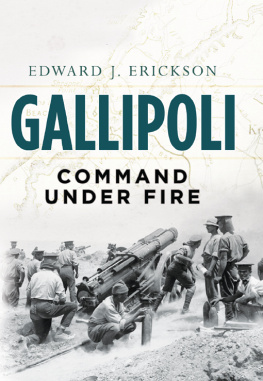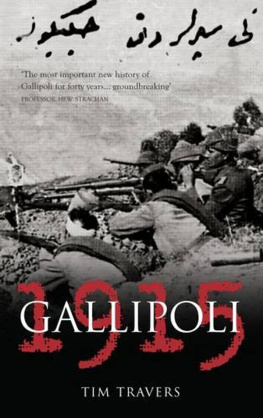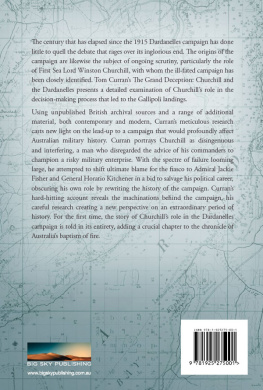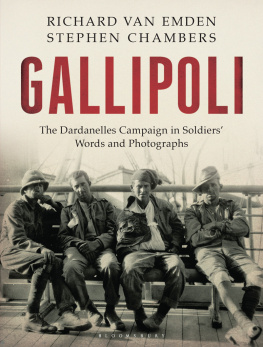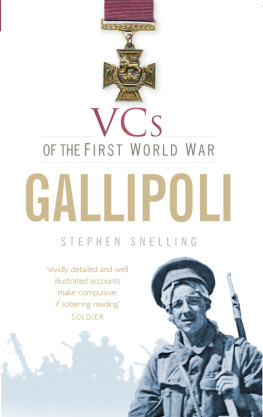GALLIPOLI

EDWARD J. ERICKSON
GALLIPOLI
COMMAND UNDER FIRE
CONTENTS
Dedicated to my friend, colleague and comrade-in-arms Professor Gordon Rudd, PhD, Lieutenant Colonel, US Army (Retired) for his encouragement and friendship, and from whom I never stop learning new things.
ACKNOWLEDGEMENTS
In addition to my friend and colleague, Professor Gordon Rudd (to whom this book is dedicated), I would like to acknowledge the many contributions of myfriends and colleagues in the production of this book. First and foremost is my editor, Marcus Cowper, without whose advice and interest this book would not have been either written or produced. Thank you, Marcus! I am also indebted to Brigadier Chris Roberts (Australian Army, retired) and ProfessorMesut Uyar (Colonel, Turkish Army, retired), who have steadily and faithfully replied to my many questions with solid answers and suggestions. Ihave reached out successfully to a variety of established international scholars and historians with questions, and for advice, as well, and these include Peter Hart (UK), John Lee (UK), Rhys Crawley (Australia), Graham Clews (Australia) and Klaus Wolf (Germany). I have relied heavily on your brilliant published work and I thank you for your direct and indirect help. At the MarineCorps Command and Staff College in Quantico, Virginia, the active encouragement of Dr. Doug McKenna, the Dean of Academics, and my teaching colleague Colonel Frode Ommundsen (Norwegian Army) have been a constant source of support. At the Marine Corps School of Advanced Studies (SAW), Professor Rudds colleague ProfessorBrad Meyers insights on the nature of command and control were also most helpful. I am also indebted to my students at the Command and Staff College who constantly force me to think critically about what I say and what I write. I would be remiss in not mentioning my copy editor RuthSheppard for her critical eye and superb work as well as our wonderful cartographers at Bounford.com. Lastly but most important, thank you MsJennifer Collins, my fiance and partner, for all you do to make my life easier and brighter day in and day out. I could not have written this book without your love and support.
LIST OF MAPS
LIST OF ILLUSTRATIONS
INTRODUCTION
According to historian George H. Cassar, there are more books written about Gallipoli in the English language than on any other campaign in the First World War. If this is true, then why should anyone attempt to add to an already dense field? Moreover, why would an informed reader take on this book? Simply stated, the extant history is incomplete and there are gaps, holes, and niches that still need to be filled in order to achieve a more complete understanding of what happened in that place over a ten-month period in 1915. In particular, the existing history of the campaign focuses on two of the three levels of war the strategic and the tactical and does not clearly separate the operational level of war, which connects the two together. Gallipoli: Command Under Fire aims at filling the gap, which exists at the operational level of war, in the historiography of the 1915 struggle for the Gallipoli peninsula by examining command and control at field army and corps level.
Conceptually, the operational level of war links the tactical level of war with the strategic level of war. In the 19th and 20th centuries, the operational level of war manifested itself as the planning and execution of a series of major battles or campaigns designed to achieve strategic goals. As a matter of military practice, the operational-level environment is the playing field of army and army group commanders, who employ large-scale units, such as corps, groups and, sometimes, divisions in the conduct of military operations. It is important to note that a campaign is not the same as a battle, which is tactical in scope and usually involves smaller units, such as battalions and regiments or brigades. In effect, the operational level of war describes military campaigns, which are designed to link tactical actions to strategic purposes.
Military operations at the operational level tend to be longer in temporal terms and larger in scope than a single battle, although a single battle may decide a campaign. Commanders at the operational level do not fight battles in the present time; rather, they marshal resources and plan campaigns in the future. They exercise indirect control through subordinate commanders rather than direct control of tactical units. Many military historians consider Napoleon to be the original practitioner of the operational level of war, the hallmarks of which were the waging of large-scale campaigns, employing a number of intermediate commanders (of subordinate armies or army corps), who executed written orders independently. Moreover, at this new level, the term battlefield itself sometimes came to mean an entire country or province. In turn, increasing complexity in the scale of operations and logistics led to the creation of specialized staffs to support extended operations. These innovations in command and control led to a revolution in military affairs characterized by written orders, indirect command by assigning missions (rather than command by personal direction), and reliance on the initiative and capability of subordinate commanders. In this book, the terms in the phrase command and control are used in the context of making decisions and influencing the outcome respectively in short, command is all about decisions and control is all about execution.
The question that this book seeks to answer is to what extent did command and control at the operational level of war affect the outcome of the Gallipoli campaign? This book is, therefore, a campaign analysis of how operational commanders made decisions; balanced ends, ways and means; and attempted or in some cases failed to influence the outcome. It examines institutions, organizations, doctrines, commanders, and events using direct comparison and contrast to expose the interaction of forces as the campaign progressed from planning to execution to conclusion. The thesis of Gallipoli: Command Under Fire is that Ottoman command and control was more effective than British command and control, and significantly weighted the conduct and outcome of the campaign in the Ottomans favour.
The historiography of the Gallipoli campaign the history of the history began in 1915 and continues today. It is important for the reader to consider that what we think of as history is a package of facts selected to support a particular narrative. History is not what might be termed the truth and, over time, history itself is evolutionary and itself becomes part of the historiography (or the body of historical literature) of events. Gallipoli has a distinct historiography that is the outcome of an evolving narrative that served a particular agenda, which was contextually important to a particular era. I believe that the 100-year-old historiography of the Gallipoli campaign is in its fourth narrative generation.
Almost immediately after the ending of the Gallipoli campaign in January 1916, a number of participant memoirs appeared in the United Kingdom. These were followed by the publication of the parliamentary Dardanelles Commissions in 1917 and 1919, as the British government struggled to understand and explain why the empire had gone down in defeat to the power that had become known as the Sick Man of Europe. After the armistice in 1918, numerous regimental histories and personal memoirs were published, most notably by the British commander, General Sir Ian Hamilton, who published his two-volume Gallipoli Diary
Next page
